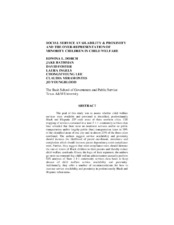| dc.contributor.advisor | Dorch, Edwina | |
| dc.creator | Bathman, Jake | |
| dc.creator | Foster, David | |
| dc.creator | Ingels, Laura | |
| dc.creator | Lee, Chongmyoung | |
| dc.creator | Miramontes, Claudia | |
| dc.creator | Youngblood, Jo | |
| dc.date.accessioned | 2015-05-20T19:17:51Z | |
| dc.date.available | 2015-05-20T19:17:51Z | |
| dc.date.issued | 2010 | |
| dc.identifier.uri | https://hdl.handle.net/1969.1/154254 | |
| dc.description.abstract | The capstone group assessed whether child welfare services were available and proximal in predominantly low income, black areas with high foster care rates in three southern cities. GIS mapping of services contained in a State 211 community services database revealed that there were no treatment services and/or no public transportation and/or lengthy public transportation times in nearly 25% of the identified areas in the three cities combined. The authors suggest that increasing child welfare service availability and proximity could reduce the overrepresentation of black children in foster care by making services available and proximal to black parents. The authors recommend that child welfare administrators perform annual GIS analyses of State 211 community services databases to assess child welfare service availability. The authors offer a number of recommendations for increasing child welfare service availability and proximity in high foster care areas. | en |
| dc.language.iso | en_US | |
| dc.rights | Attribution-NonCommercial-NoDerivatives 4.0 International | en |
| dc.rights.uri | http://creativecommons.org/licenses/by-nc-nd/4.0/ | |
| dc.title | Social Service Availability & Proximity And The Over-Representation Of Minority Children in Child Welfare | en |
| dc.type | Technical Report | en |
| dc.contributor.sponsor | State of Texas, Department of Family Protective Services | |



